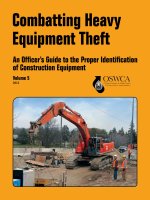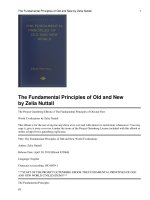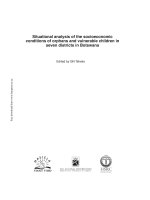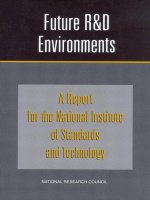Procedures for the Proper Disposition of Equipment and Materials Through Lion Surplus pot
Bạn đang xem bản rút gọn của tài liệu. Xem và tải ngay bản đầy đủ của tài liệu tại đây (1.62 MB, 25 trang )
Procedures for the Proper Disposition of
Equipment and Materials Through
Lion Surplus
The Pennsylvania State University
Environmental Health and Safety
May 2006
Environmental Protection ~ Occupational Health and Safety ~ Radiation Protection
Environmental Protection ~ Occupational Health and Safety ~ Radiation Protection
Table of Contents
I. Introduction 1
II. Items Prohibited from Sale or Transfer
A. Asbestos Containing Material 2
B. Batteries 4
C. Fire Extinguishers 5
D. Gas Cylinders 6
E. Mercury 8
F. Polychlorinated Biphenyls (PCBs) 10
III. Items with Regulatory or Safety Restrictions as to Sale or Transfer
A. Computer and Monitors 11
B. Gas Chromatographs 12
C. Laser Systems 13
D. Liquid Scintillation Counters 15
E. Radiation-Producing Equipment 16
F. Equipment Containing Coolants, Oils, and Refrigerants 18
IV. Equipment and Labware used with Chemicals, Petroleum Products, 20
Oils, Infectious Agents, or Radioactive Materials
V. Quick Reference Chart 23
I. Introduction
Lion Surplus, formerly known as Surplus and Salvage, operates a public sales store
open to students, faculty, staff and the general public. Lion Surplus is responsible for
the collection, sale, and disposal of University-owned equipment, supplies and
materials that are obsolete or surplus to the needs of Penn State.
Some equipment and material may not be appropriate for resale due to the presence of
hazardous materials, characteristics, or regulatory constraints. It is the responsibility
of the equipment owner to ensure that all oils, coolants, and other hazardous materials
have been removed prior to submitting the item for disposition through Lion Surplus.
Items that may be contaminated by chemical, biological, or radioactive material must
be cleaned prior to submission to Lion Surplus.
The descriptions provided on the following pages are examples of the types of
hazards and potential items that may be a concern. This is not intended to be a
complete and all encompassing list but rather a summary compilation of existing
policies and best practices. It is not intended to replace or supercede any established
university safety policies.
Questions about a potentially hazardous item or material should be directed to
Environmental Health and Safety, 814-865-6391, for resolution. Any spills during
transport, loading, unloading, or storage must be reported to the appropriate
supervisor and EHS immediately. Clean-up costs will be charged to the equipment
owner.
In all cases, items recognized as being a potential problem will be left at the pickup
location. Lion Surplus, with EHS, will work with the respective departments to
evaluate the item and expedite processing.
To dispose of surplus material complete and submit a DISP from through IBIS. If
IBIS is inaccessible, departments may submit two copies of Form GF6.2, Report of
Transfer or Disposition of Equipment Form, to Property Inventory. This form is
available through FormLocator on GURU at: />02ReportOfDispositionOrPermanentTransferOfTangibleAssetsFRM3.pdf . Upon
receipt of the request, Lion Surplus will arrange to pick up the surplus item.
Environmental Protection ~ Occupational Health and Safety ~ Radiation Protection
1
II. Items Prohibited from Sale or Transfer
A. Asbestos Containing Material (ACM)
1. Description
a. Asbestos is a naturally occurring fibrous mineral that was used
extensively for its insulating and fireproof properties. It is often white
or gray in appearance and may be in the form of braided or paper wire
insulation, woven cloth-like material, cement-like sheeting known as
Transite or stone lab bench tops (soapstone).
b. Handling and disposal of asbestos is strictly regulated by the
Environmental Protection Agency (EPA), the PA Department of
Environmental Protection (PA DEP) and the PA Department of Labor
and Industry (PA L&I).
c. Contact EHS for confirmation as to whether the item contains
asbestos. For additional information on the university’s Asbestos
Management Program, please see:
/>anual.pdf
2. Associated Hazards
a. Long term over-exposure to airborne asbestos fibers has been shown to
cause lung and abdominal diseases, specifically asbestosis and cancer.
Since asbestos is naturally occurring, there are allowable exposure
limits.
b. Manipulating asbestos containing materials (e.g. drilling, sanding, or
sawing) may generate dangerous levels of respirable asbestos fibers.
These activities are strictly regulated and can only be conducted by PA
L&I licensed Asbestos Workers using equipment and procedures that
are specifically approved for these materials.
3. Procedures for Proper Disposition
a. For disposal at University Park, a Work Order must be submitted
through OPP Area Services. This may require the disposal of entire
pieces of equipment.
b. For disposal at facilities other than University Park contact EHS for
guidance.
c. Disposal costs are the responsibility of the originating work unit.
Examples of asbestos containing material can be found on the following page.
Environmental Protection ~ Occupational Health and Safety ~ Radiation Protection
2
Examples of asbestos containing material.
Asbestos Braiding Transite Board inside Hood
Transite Sheet on Water Bath Soapstone Bench Top
Asbestos Glove Pipe Insulation
Environmental Protection ~ Occupational Health and Safety ~ Radiation Protection
3
B. Batteries
1. Description
a. Expended batteries such as nickel-cadmium, lithium ion, and those
found in uninterrupted power supply (UPS) systems contain hazardous
materials including heavy metals and acids. Lion Surplus will not
accept batteries except as part of functional equipment.
b. Disposal of hazardous materials is regulated by the Environmental
Protection Agency (EPA) and the Pennsylvania Department of
Environmental Protection (PA-DEP).
c. For additional information and guidance on proper battery disposal,
please see:
2. Associated Hazards
a. Mercury and other heavy metals can cause a variety of health effects
including kidney and neurological damage.
b. The acid contained in some batteries can cause skin and eye burns.
c. Improper disposal of hazardous chemicals may result in the
contamination of soil and ground water.
3. Procedures for Proper Disposition
a. Complete and submit a Chemical Waste Disposal Request Form on the
EHS web site:
. For University Park, EHS has established recycling and disposal options
for rechargeable batteries. Plans are under way for expanding this
recycling program to other campus locations.
b. For University Park, disposal of vehicle batteries can be arranged
directly through the Office of Physical Plant’s vehicle maintenance
garage, 814 – 865 – 3871. At other campus locations disposition may
be handled by the maintenance garage services or local recyclers.
c. Alkaline batteries may be disposed of in the regular trash.
Examples of batteries that may contain hazardous material.
Rechargeable Batteries UPS Battery
Environmental Protection ~ Occupational Health and Safety ~ Radiation Protection
4
C. Fire Extinguishers
1. Description
a. Fire extinguishers come in a variety of styles including pressurized
water, chemical powder, CO2, halon, and specialty extinguishers
designed to put out metal fires.
2. Associated Hazards
a. Fire extinguishers are pressurized devices that may cause serious
injury if ruptured.
b. Fire extinguishers may not operate in an emergency if improperly
maintained.
3. Procedures for Proper Disposition
a. For University Park, a work order must be submitted through the OPP
Service Desk to arrange for the removal and disposal of fire
extinguishers.
b. For campuses other than University Park contact EHS for guidance on
proper disposition.
CO-2 Extinguisher Industrial Size
Class A Water Filled Class D for Metal Fires
Environmental Protection ~ Occupational Health and Safety ~ Radiation Protection
5
D. Gas Cylinders
1. Description
a. Gas cylinders are manufactured in a variety of styles and are used to
store compressed or liquefied gasses under high pressure. Examples
include:
• Laboratory gas cylinders
• Lecture bottles
• Commercial propane cylinders
• Oxygen bottles
• Other pressurized devices
2. Associated Hazards
a. Gas cylinders may contain hazardous or toxic gases.
b. Gas cylinders are pressurized devices that may cause serious injury if
ruptured.
3. Procedures for Proper Disposition
a. For University Park, cylinders purchased through General Stores are to
be used in accordance with SY25
( and returned through General
Stores when empty or no longer needed.
b. For campuses other than University Park, cylinders should be returned
to the gas supplier contracted for that campus.
c. For unknown or other wise non-returnable gas cylinder, the generator
shall complete and submit a Chemical Waste Disposal Request Form
on the EHS web site:
d. Other than as specified above, gas cylinder disposal costs are normally
covered by the EHS waste budget.
Examples of gas cylinders can be found on the following page.
Environmental Protection ~ Occupational Health and Safety ~ Radiation Protection
6
Examples of gas cylinders.
Calibration Gas Cylinders Lecture Bottles
Misc. Cylinders Propane Tanks
Miscellaneous Cylinders Supplied Air Breathing Apparatus
Environmental Protection ~ Occupational Health and Safety ~ Radiation Protection
7
E. Mercury
1. Description
a. Mercury, a silver liquid metal, is a toxic chemical most commonly
used in thermometers. It may also be found in certain vacuum pumps,
batteries, and many types of lab equipment where mercury
thermometers are often used but may have been broken. Other items
often found contaminated with mercury include incubators, heating
blocks, ovens, refrigerators and water baths.
b. Spilled mercury is often found when moving lab equipment or
furniture. Take a few moments to carefully check the floor or bench
top for small beads of mercury that may have spilled some time in the
past.
c. The disposal of mercury is strictly regulated by the Environmental
Protection Agency (EPA) and the Pennsylvania Department of
Environmental Protection (PA-DEP).
2. Associated Hazards
a. Mercury is a poison that can cause kidney and lung damage in high
concentrations. Mercury vapor is also a chronic poison that can cause
neurological damage.
b. Mercury spills can also lead to potential environmental implications
including soil and groundwater contamination.
3. Procedures for Proper Disposition
a. Contact EHS immediately for any mercury spills. EHS will initiate
cleanup when an item is found contaminated with liquid mercury.
Items free of mercury contamination may be sold or auctioned. If
unable to be cleaned the item will be disposed of as waste through
EHS.
b. Thermometers containing mercury should be exchanged through the
EHS thermometer exchange program. For more information on the
program please see:
c. Thermometers found intact must be removed from the item. Complete
and submit a Chemical Waste Disposal Request Form on the EHS web
site:
/>.
d. Vacuum pumps must be checked by EHS for mercury contamination
before being sold.
Examples of items that contain or may be contaminated with mercury include can be
found on the following page.
Environmental Protection ~ Occupational Health and Safety ~ Radiation Protection
8
Examples of items that may contain mercury.
Mercury Lamp Vacuum Pump
Thermometers Mercury Switch
Thermostats Blood Pressure Monitor
Environmental Protection ~ Occupational Health and Safety ~ Radiation Protection
9
F. Polychlorinated Biphenyls (PCBs)
1. Description
a. PCBs are one of several aromatic compounds containing two benzene
nuclei with two or more constituent chlorine atoms.
b. The disposal of PCBs is strictly regulated by the Environmental
Protection Agency (EPA) and the Pennsylvania Department of
Environmental Protection (PA-DEP).
c. For additional information and guidance on PCB containing light
ballasts, please see:
2. Associated Hazards
a. PCBs can cause health effects from long term high exposure.
b. PCBs are stable and do not break down in the environment.
3. Procedures for Proper Disposition
a. Notify EHS of the general description, origin, and serial number, if
available, of the item. This includes transformers and/or capacitors
that may have already been labeled as “non-PCB”. EHS will
determine if the item contains PCBs. EHS will either authorize the
items resale as a non-PCB item, or arrange for proper disposal of the
fluids.
Examples of items that may contain PCBs.
Fluorescent Light Ballasts Oil Filled Transformers
Environmental Protection ~ Occupational Health and Safety ~ Radiation Protection
10
III. Items with Regulatory or Safety Restrictions as to Sale or Transfer
A. Computers and Monitors
1. Description
a. Disposal of desktop computers, laptop computers and cathode ray tube
type (CRT) monitors is restricted.
2. Associated Hazards
a. Computer electronic components contain small quantities of toxic
heavy metals.
b. CRT type monitors also contain heavy metals including a large amount
of lead used in making the glass tube.
3. Procedures for Proper Disposition
a. Computers and monitors shall be sent through Lion Surplus for
disposition.
b. There are no special disposal requirements for flat panel type
monitors.
Examples of computers and monitors.
Environmental Protection ~ Occupational Health and Safety ~ Radiation Protection
11
B. Gas Chromatographs
1. Description
a. Gas chromatographs are analytical instruments used to separate and
identify components within a mixture of chemicals, gases, or
compounds.
b. These devices may be subject to federal and state regulations
governing the ownership and use of radioactive materials.
c. Gas chromatograph manufactures included:
• Agilent Technologies
• Hewlett Packard
• Perkin Elmer
• Shimadzu
• Varian
2. Associated Hazards
a. Some gas chromatographs (GC) contain radioactive sources known as
Electron Capture Detectors (ECDs).
b. Some equipment can be contaminated with chemical hazards.
3. Procedures for Proper Disposition
a. Contact EHS to inspect each system. If it contains a radioactive
source EHS will remove the source and perform a survey to confirm
the system is free of any radioactive contamination.
b. Once the source has been removed and the system confirmed free of
radiological and chemical contamination, the system can be sold or
auctioned without restriction.
Examples of gas chromatographs.
Hewlett Packard / Agilent Perkin Elmer
Environmental Protection ~ Occupational Health and Safety ~ Radiation Protection
12
C. Laser Systems
1. Description
a. Lasers, an acronym for light amplification by stimulated emission of
radiation, are a source of intense, coherent, directional beam of optical
radiation of either visible or invisible light.
b. Lasers can be imbedded as part of analytical and other scientific
equipment.
c. For additional information and guidance on the university laser safety
policy; http//guru.psu.edu/policies/SY17.html
2. Associated Hazards
a. Laser light can damage the eyes and burn unprotected skin.
b. Laser systems can contain hazardous chemicals, coolants, oils or dyes
used to generate the laser beam.
3. Procedures for Proper Disposition
a. Systems in working order may only be resold to the original
manufacture or other manufacturer of similar equipment; a
manufacturer certified installer and/or representative, educational or
research institutions, or private companies who currently use similar
equipment.
b. Potential buyers of Class 3B or 4 lasers, or systems with imbedded
Class 3B or 4 laser systems shall provide a letter or email to Lion
Surplus, traceable to the business, educational, or research institution,
acknowledging their experience and awareness of the hazards
associated with the equipment. This letter must include information as
to the intended use of the equipment and contact information for their
safety department or representative. EHS will review the proposed
buyer's information and make a recommendation approving or
disapproving the sale.
c. When a suitable buyer for a Class 3B or 4 lasers, or systems with
imbedded Class 3B or 4 systems, cannot be found, or if the potential
sale is not justifiable financially, the system must be made inoperable.
EHS is responsible for ensuring that the system has been made
inoperable.
d. Laser systems may also contain hazardous chemicals, coolants, oils, or
dyes used to generate the laser beam. It is the responsibility of the
owner of the equipment to drain the equipment and arrange for
disposal of the hazardous materials through EHS before requesting the
system be picked up by Lion Surplus.
e. Class 1, 2, and 3A lasers, with no imbedded Class 3B or 4 systems,
may be sold without restriction.
Examples of several types of lasers can be found on the following page.
Environmental Protection ~ Occupational Health and Safety ~ Radiation Protection
13
Examples of various types of laser systems.
Environmental Protection ~ Occupational Health and Safety ~ Radiation Protection
14
D. Liquid Scintillation Counters
1. Description
a. Liquid scintillation counters (LSC ) are analytical instruments used to
measure very low levels of radioactive materials.
b. These devices may be subject to federal and state regulations
governing the ownership and use of radioactive materials.
c. Manufactures of LSCs have included;
• Beckman
• LKB
• Packard
• Wallac
2. Associated Hazards
a. Liquid Scintillation Counters (LSC) typically contain internal
radioactive sources.
3. Procedures for Proper Disposition
a. Contact EHS to inspect each system. If it contains a radioactive
source EHS will remove the source and perform a survey to confirm
the system is free of any radioactive contamination.
b. Once the source has been removed and the system confirmed free of
radiological and chemical contamination, the system can be sold or
auctioned without restriction.
Examples of liquid scintillation counters.
Beckman Model LKB Model
Environmental Protection ~ Occupational Health and Safety ~ Radiation Protection
15
E. Radiation-Producing Equipment
1. Description
a. Radiation-producing equipment includes a variety of analytical
instruments typically used to study the structure and composition of
materials.
b. These devices are subject to state and federal regulations governing the
ownership, sale, and transfer of such devices.
c. Radiation-producing equipment includes the following:
• Analytical and Fluorescence Systems
• Electron Microscopes
• Electron Spectroscopy for Chemical Analysis Systems (ESCA)
• Medical Radiograph and Fluoroscope Systems
• X-ray Photoelectron Spectroscopy Systems (XPS)
• X-ray Vacuum Spectroscopy Systems
d. For additional information and guidance on the university’s radiation-
producing equipment policy; http//guru.psu.edu/policies/SY15.html
2. Associated Hazards
a. High level exposure to X-ray radiation is associated with immediate
health risks and long term risk of increased cancer incidence.
b. X-ray systems may also contain hazardous chemicals, coolants, and
oils.
3. Procedures for Proper Disposition
a. Penn State restricts the sale of all radiation producing equipment.
Systems may only be resold to the original manufacture or other
manufacturer of similar equipment; a manufacturer certified installer
and/or representative, educational or research institutions, or private
companies who currently use similar equipment.
b. Potential buyers of radiation producing equipment shall provide a
letter or email to EHS acknowledging their experience and awareness
of the hazards associated with the equipment. The letter must state the
intended use of the equipment and include their safety department or
representative contact information. EHS will review the proposed
buyer's information and make a recommendation approving or
disapproving the sale.
c. When a suitable buyer for system cannot be found, or if the potential
sale is not justifiable financially, the system must be made inoperable.
EHS is responsible for ensuring that the system has been made
inoperable.
d. It is the responsibility of the owner of the equipment to drain the
equipment and arrange for disposal of the hazardous materials through
EHS before requesting the system be picked up by Lion Surplus.
Examples of radiation-producing equipment can be found on the following page.
Environmental Protection ~ Occupational Health and Safety ~ Radiation Protection
16
Examples of radiation-producing equipment.
X-ray Vacuum Spectroscopy System Electron Microscope
Analytical X-ray Unit Physics Lab Demonstration X-ray Unit
Environmental Protection ~ Occupational Health and Safety ~ Radiation Protection
17
F. Equipment Containing Coolants, Oils, and Refrigerants
1. Description
a. Equipment that contains coolants, oils, and refrigerants, such as
refrigerators, freezers, air conditioners, milling machines, cutting
lathes, hydraulic presses, and vacuum pumps require proper processing
prior to final disposition.
2. Associated Hazards
a. As part of a working system, coolants, oils, and refrigerants do not
typically pose a hazard. However, when an item is no longer useable,
federal and state regulations require the recovery of these hazardous
materials before items are disposed and materials accidentally released
to the environment.
b. Compressors may also contain a significant amount of oil.
c. Refrigerators and freezers that have been used to store chemicals,
infectious agents, or radioactive materials must be cleaned and
decontaminated of any hazardous material before being offered to
Lion Surplus.
3. Procedures for Proper Disposition
a. Items that may have been in contact with chemicals, infectious agents,
or radioactive materials must be decontaminated prior to being offered
to Lion Surplus. Contaminated equipment can usually be effectively
decontaminated with common disinfection techniques. Contact EHS
and inform them of the type of equipment and nature of the
contaminant. EHS will advise as to proper steps necessary to assure
proper decontamination.
b. Equipment in working order and containing coolants, oils, and
refrigerants as part of the equipments function and design may be
transferred to Lion Surplus for sale. If the equipment contains a
reservoir tank, such as those on milling machines, the tank must be
drained and the material disposed through EHS.
c. Equipment that is not functioning must have coolants, oils, and
refrigerants removed prior to transfer to Lion Surplus. Refrigerants
must be recovered by an EPA certified technician. For University
Park, a work order must be submitted through the OPP Service Desk
to arrange removal of the refrigerant.
d. Equipment that is not functioning and contains a compressor must
have the oil drained and collected for disposal as hazardous waste.
Complete and submit a Chemical Waste Disposal Request Form on the
EHS web site:
/>.
e. For campuses other than University Park contact EHS for guidance on
proper disposition.
Examples of equipment containing coolants, oils, and refrigerants can be found on the
following page.
Environmental Protection ~ Occupational Health and Safety ~ Radiation Protection
18
Examples of equipment containing coolants, oils, and refrigerants.
-80- Freezers Standard Refrigerator / Freezer
Air Conditioning Units Vacuum Pumps
Drill Presses, Milling Machines, Lathes and Machine Tools that use Cutting Oils
Environmental Protection ~ Occupational Health and Safety ~ Radiation Protection
19
IV. Equipment and Labware used with Chemicals, Petroleum Products, Oils,
Infectious Agents, or Radioactive Materials
1. Description
a. Equipment and labware that has been used with chemicals, petroleum
products, oils, infectious agents, or radioactive materials must be properly
cleaned and free of any harmful contaminants before being offered to Lion
Surplus for sale.
b. Excess and unneeded products such as janitorial chemical supplies, empty
drums, paint and other items may not be appropriate for resale and may be
prohibited due to regulatory constraints.
c. Items may require special processing and approval include:
• Above ground storage tanks
• Autoclaves
• Biological safety cabinets
• Centrifuges and micro-centrifuges
• Diagnostic or therapeutic medical and athletic equipment
• Empty drums
• Equipment used to apply insecticides or pesticides
• Glassware
• Heating blocks
• Hoods, including laminar flow hoods
• Incubators
• Laboratory furniture / cabinets
• Ovens
• Petroleum storage tanks
• Refrigerators / Freezers
• Vacuum pumps
• Vortexes
• Water baths
2. Associated Hazards
a. Equipment contaminated with chemicals, infectious agents, or radioactive
materials can present an exposure hazard to someone unaware of the
contamination. Individuals who handle or reuse such equipment may
become infected by inadvertent exposure to these agents.
b. A wide variety of health effects may result from exposure to hazardous
chemicals.
c. The residues remaining in “empty” containers may render the container
incompatible with certain intended uses after resale.
3. Procedures to Ensure Proper Disposition
a. Items that may have been in contact with chemicals, infectious agents, or
radioactive materials must be decontaminated prior to being offered to
Lion Surplus. Contaminated equipment can usually be effectively
Environmental Protection ~ Occupational Health and Safety ~ Radiation Protection
20
decontaminated with common disinfection techniques. Contact EHS and
inform them of the type of equipment and nature of the contaminant. EHS
will advise as to proper steps necessary to assure proper decontamination.
b. Contact EHS regarding the proper disposition of surplus materials such as
paints, refrigerants, or janitorial chemical cleaning supplies. EHS will
either approve the transfer of the materials to Lion Surplus for sale or
dispose of the material as chemical waste
c. Empty chemical containers that are 5 gallons or greater in size should be
referred to EH&S for disposal. Empty containers less than 5 gallons can
be disposed of through the regular trash system.
Examples of equipment and labware used with chemicals, petroleum products, oils,
infectious agents, or radioactive materials can be found on the following page.
Environmental Protection ~ Occupational Health and Safety ~ Radiation Protection
21
Examples of potentially contaminated items.
Empty Drums Surplus Chemicals
Heating Block Laminar Flow Hood
Examination Table Fuel Storage Tanks
Environmental Protection ~ Occupational Health and Safety ~ Radiation Protection
22
Environmental Protection ~ Occupational Health and Safety ~ Radiation Protection
23
V. Quick Reference Chart
Item See page Contact
Analytical X-ray Unit 16 EHS
Asbestos 2 OPP
Autoclaves 20 EHS
Batteries, Rechargeable 4 EHS
Biological Safety Cabinet 20 EHS
Centrifuges and Micro-centrifuges 20 EHS
Computers and Monitors 11 S&S
Drums (empty) 20 EHS
Electron Microscope, Scanning and Transmission 16 EHS
Electron Spectroscopy for Surface Chemical Analysis (ESCA) 10, 16 EHS
Fire Extinguishers 5 OPP
Freezers, including –80’s 18, 20 OPP, EHS
Freon 18 OPP
Gas Cylinders 6 GS, EHS
Glassware 20 EHS
Heating Blocks 8, 20 EHS
Hoods 2, 20 OPP, EHS
Incubators 8, 20 EHS
Laboratory Furniture and Cabinets 20 EHS
Laminar Flow Hood 20 EHS
Lasers 13 EHS
Lecture Bottles 6 GS, EHS
Machine Tools that use Cutting Oils 18 EHS
Mercury, including Lamps and Switches 8 EHS
Ovens 2, 8, 20 OPP, EHS
PCB’s 10 EHS
Propane Tanks 6 GS, EHS
Radiographic X-ray Unit 16 EHS
Refrigerants 18 OPP
Refrigerators 8, 18, 20 OPP, EHS
Soapstone 2 OPP
Transite 2 OPP
UPS-Uninterrupted Power Supply 4 EHS
Vacuum Pumps 8, 18, 20 EHS
Vortexes 20 EHS
Water Baths 8, 20 EHS
X-ray Equipment 10, 16 EHS
X-ray Photospectroscopy Systems 10, 16 EHS
Contact List:
EHS Environmental Health and Safety www.ehs.psu.edu 814 – 865 – 6391
GS General Stores www.generalstores.psu.edu 814 – 863 – 0317
OPP Office of Physical Plant www.opp.psu.edu 814 – 863 – 2340
S&S Lion Surplus www.surplus.psu.edu 814 – 865 – 4371









